What is it – smoke and mirrors or bountiful possibility?
by M.E.A. McNeil
“It’s a really rough world out there for bees,” said Eric Mussen, UC Davis emeritus apiculturist. Our bees are just too weak. They are not healthy, not robust.”
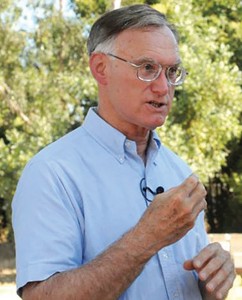
Eric Mussen (photo by Kathy Keatley Garvey)
“The average life of a colony is six months now,” said beekeeper Bret Adee, who experienced the loss of 40,000 colonies over three weeks. It was “a big red flag. I started out with self-interest, but the more I learned, it concerns everyone – our children and grandchildren.”
The guy who has been putting numbers to it, Dennis vanEngelsdorp of the Bee Informed Project, said, “The bees are not just dying during stressful times, they are dying all the time. What’s shocking to me is that the losses in Summer, which should be paradise for bees, exceeded the Winter losses.”

Dennis vanEngelsdorp.
For years we have yammered on the same themes: Pollinators deeply affect our lives – and vice versa. Honey bees are an index species, indicating the status of the environment. “Every third bite” is a research-based statement that, together with apocalyptic statistics, at last, has gotten public attention.
All the U.S. bee scientists – those who actually do peer-reviewed research – could be accommodated at a good-sized dinner party. A celebrated big money infusion for their work, the largest grant thus far ($5 million divided among 16 universities), would pay for some 20 minutes of the Iraq war.
These scientists, together with beekeepers have been crying uncle. And Uncle Sam has responded with a sweeping government-wide plan to take on the problem. If nothing else, it is huge. But is it wonderful? Humbug? Impossible? Far from enough? Best we can get? Whatever it is, by all accounts it is a federal mandate unique in its breadth, and it bears examination.
The genesis of the document is President Obama’s June 20, 2014 Memorandum directing every department of government to come up with a pollinator plan. The Strategy came out over the signatures of the Secretary of Agriculture, Tom Vilsak, and the Administrator of the EPA, Gina McCarthy. Its goal is to “reverse pollinator losses and help restore populations to healthy levels” for the nation’s struggling honey bee, native bee and Monarch butterfly. The butterflies are integral to the whole, but we’ll talk bees here.
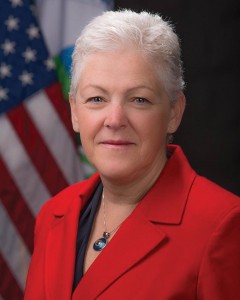
Gina McCarthy
The plan envisions reducing honey bee loss to 15% in 10 years and adding seven million acres of wildflower habitat by 2020. To pull that off, a call has been issued for “all hands on deck”. It will take considerable coordination for a crew consisting of federal agencies, state and local governments, universities, nonprofit groups and citizens to raise the sails – especially since everyone but the feds needs to opt in. At this point navigation is charted in two documents published in May: the National Strategy to Promote the Health of Honey Bees and Other Pollinators1 and the Pollinator Research Action Plan, which has sections on Habitat and Native Plant Development; Nutrition; Pathogens and Pests; Pesticides and Toxins; Genetics and Breeding; Economics; Collections; Models; Partnerships.2
Those without the time or fortitude to wade through the Strategy as well as the Action Plan’s dense chapters and appendices could wonder: Is there a pony in here somewhere?
“There is a whole stable of them,” said May Berenbaum, Professor and Head of Entomology at the University of Illinois. “There is very little a president can do on his own, but by creating this initiative for all agencies it is a brilliant idea. It is a substantive change in one fell swoop. It benefits pollinators across the board. This is achievable, affordable and doable, a great idea – not optimized but maximized.”

May Berenbaum.
“What’s important is the fact that this document even exists,” said Christian Krupke, Associate Professor of Entomology at Purdue University. “As recently as a few years ago there was no admission that there was a problem. It’s a commitment to huge, ambitious goals. I think it’s a strong document.”
“It’s fantastic that we have a national Pollinator Strategy,” said Claire Kremin, Professor of Conservation Biology and Entomology, UC Berkeley. “It’s unprecedented.”
“My take is positive,” said Keith Delaplane, Professor and Honey Bee Program Director, University of Georgia. “These documents come around once in a blue moon. By necessity they paint with a broad brush – broad notions, key priorities.”
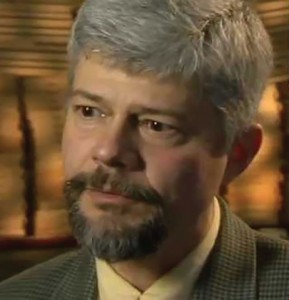
Keith Delaplane
“It is a great initiative,” said Dewey Caron, professor emeritus, University of Delaware. “It is already off to a good start. There will be some innovative thinking coming out of this.”
“My overall impression is that it seems surprisingly balanced, said vanEngelsdorp, who, in addition to his role with BIP is Assistant Professor of Entomology at the University of Maryland. “It’s surprising because of the number of pressures involved. It got the main drivers right – Varroa, nutrition, pesticides. And it is honest about the knowledge gaps. What remains is how to evaluate data.”
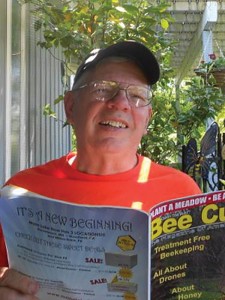
Dewey Caron
“This has real meat,” said Laurie Adams of the Pollinator Partnership. “Compare it to the strategies from England and France, which state only intent. This is specific, comprehensive – a great start.”
“Now we need to do the work,” said Krupke. “We are not going to make big changes but a lot of small ones. People looking for a quick fix are not going to get it. Honey bee research is very difficult.”
“We are waiting to hit the ground running,” said Juliana Rangel, Assistant Professor of Apiculture, Texas A&M University. “It’s finally here. The researchers are anxiously waiting for funding to be defined. It’s sad it’s gotten to this point, but exciting that there is now momentum.”
The 15%
“Winter losses down to 15% in 10 years: It’s a great goal,” said beekeeper Dave Hackenberg. “We were there before systemics. I’ve been running bees like this since I was in my 20s, and we didn’t have these kinds of losses.”
“We need an annual loss target,” said vanEngelsdorp. “The 15% came out of asking beekeepers in the Winter Loss Survey. The 15% goal is doable.”
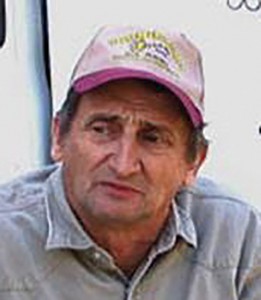
Dave Hackenberg
Now What?
Looming over the whole Strategy are some big if’s. “The question is,” said Caron, “Does it have legs? It is very ambitious, doable, reasonable, but it won’t be done by doing business as usual. Is there follow-up?”
“They have put out enough questions to keep researchers going for decades,” said Krupke “There is no shortage of competent scientists interested, but the funding rate for grant applications is 5 to 7%. A lot of good science is not funded.”
“How does this story unfold?” said vanEngelsdorp. “Long-term differences will have to be ironed out. It won’t be perfect. How do we make it more perfect?”
Onward Into the Gaps
Dissent? Of course there is. “Every document from the government will fall short of what an individual stakeholder would write for himself,” said Adams. “We still need to pick it apart page by page, but it is enough to drive change. Let’s accomplish this much while we address what more has to be done.”
Although some criticism reads like shots from the hip, much of it is valuable and well grounded – with points that will be covered as they apply to each section.
“We didn’t identify all the gaps because we didn’t know what’s possible,” said Jay Evans, Project Leader at the Beltsville lab, USDA-ARS (Agricultural Research Service, which oversees the bee labs). “This document reflects what we know so far – but there is more to be identified.”
How It Came Together
At best, the Plan works from both ends: How to select or understand pollinator resistance to stressors and, from the other end, to reduce the stressors by examining more closely pesticide permits, increasing forage habitat and educating the public.
The Plan was created with multiple inputs. “Long before this presidential strategy, a lot of work was done in support of pollination,” said Adams. Although the documents are government-written, many pollinator advocacy and environmental groups submitted memoranda of understanding. Researchers and NGO heads convened at a White House meeting.
The ARS follows a five-year plan, taking into account land-grant university research. “It takes two months of brainstorming,” said Lilia De Guzman, Research Entomologist at the Baton Rouge lab. “Scientists come up with ideas, meet, present, and critique – especially methods.” The current five-year plan provided a working base for Jeff Pettis, Research Entomologist at the USDA-ARS Beltsville lab, together with Kevin Hackett, USDA National Program Leader for Crop Production and Protection.
“We started by canvassing,” said Pettis. “We spent a lot of time assessing what had been done and what we were missing. There was a lot of dialogue across agencies – some who haven’t talked much.”
“It was democratically done,” said Evans. “It’s not NASA, but the genome project [published in 2006] brought out consortium papers that were not that common before – field biologists, geneticists and others. This [Plan] was mandated to be written within the government, but we have all been collaborating. It is on purpose that there is no particular assignment for each goal. If there is someone better to do a task than a government agency, then we can turn to them.”
“Teams form naturally, the ties come together,” said Pettis.
The Strategy and the Action Plan came out less than a year after the mandate – lightning speed in government time, and in anyone else’s, given the number of pieces to assemble. We have “things on paper that we have never had before,” said Adams.
IPM
Because one observation was repeated in many of two dozen interviews for this article, it deserves comment. Although Integrated Pest Management (IPM) is mentioned in the Plan, it is not addressed as a viable alternative. It describes pesticide use as “a core component of integrated pest management (IPM) programs.” The reverse is true: the core concept of IPM is the use of nontoxic methods first, leaving chemical treatment as a last resort.
“I think there is one major gap,” said Kremin. “The stance of the whole Strategy itself doesn’t question the continued use of pesticides. I quote, ‘It is the misuse and overuse of these pesticides that leads to adverse ecological and human health consequences.’ It’s not questioning the actual paradigm of pesticide usage. A major research goal needs to be to find alternatives to pesticide use – promoting diversified farming systems, integrated crop pollination, natural predators, cycles of pests, crop rotation, habitat for natural enemies.”
“Just not using pesticides is a question that needed to be more discussed,” said Krupke. “It would’ve helped to have a section on that subject – on nonchemical agriculture. That is tunnel vision, and the document is not as diverse as it could’ve been. There is not a strong declarative statement whether there is any benefit from doing it this way. There are vague statements about IPM.”
“This document assumes that pesticides are in the ballgame and we’re going to find out how bad they are,” said William Quarles, a chemist who edits the Integrated Pest Management Quarterly. “But there is no alternative proposal.”
“I am looking for change,” said Berenbaum. “IPM was formulated in 1959. It was a great idea then, it is a great idea now – for the grower, the consumer. As a nation we seem incapable to understand the approach. There are so many forces allied against it. We are so American about this. A little is good, more is better.”
“We have defunded extension,” said vanEngelsdorp. “Those are the people who used to go out and count pests to say now is the time to use pesticides. Now chemical company reps do this and they have an economic stake. There is a whole network that needs to be in place.”
“We’re trying to educate beekeepers on IPM,” said Rangel, because we are creating resistance to agrochemicals.”
Jim Frazier, Professor Emeritus of Entomology at Penn State, was on the faculty of Mississipi State when IPM was developed there through consensus among biologists. At the time, cotton farmers in the state of Mississippi used more than half of the pesticides used in the nation. With an IPM program, a sterile male release all but eliminated the boll weevil in the U.S. “It’s a great success story,” he said. “In this [federal] proposal, IPM is ironic because treatment of seeds is not considered a pesticide application. The portion that goes into the plant is there all season long, which is the maximum way to develop resistance – the opposite of IPM. It is long known when insects create resistance to one pesticide, often a cross resistance to another is created. It’s is biological suicide, a huge disconnect between reality and policy. Ag/chem dismisses this, the consequences be damned. It’s completely biologically stupid.”
“We have to really rethink the way we do agriculture,” said Mark Winston, Professor of Apiculture and Social Insects at Simon Fraser University.
Goals for benign replacement of toxic chemicals can be found in the Plan. By any other name, they are the kinds of tools used in IPM, from breeding to bio controls – such as biopesticides and microbes as natural protectants being researched at the Tucson bee lab by Kirk Anderson, Lead Scientist, Molecular/Microbial Ecologist. These approaches could one day be front and center – such as the following one.
The Other Bees
The Strategy brings cautious optimism with its inclusion of native bees for study and support. An important IPM model is the attraction of native bees for a system called Integrated Crop Pollination (ICP). One large USDA funded ICP program looks at the status of native pollinators for major crops in 10 states – with over 40 species identified as pollinating apples.3
Kremin points out that an abundance of varied pollinators enhances pollination, and with almonds, the addition of native pollinators can double effectiveness. She is working on projects to plant hedgerows of native plants to support native pollinators as well as honey bees. Xerces is collaborating with almond growers and has thus far planted miles of hedgerows and acres of cover crop. Project Apis m’s Seeds for Bees is a major contributor to that goal.4
What is known is that native bees are at greater risk from pesticide: “Honey bees have a kind of buffer system to process it,” said Mussen. “But it goes directly to the native bees. That’s getting the material straight, there is no buffer.”
“We need a baseline population of native bees,” said Neal Williams, Associate Professor and Pollination Ecologist at UC Davis. “It is a very expensive undertaking, with hours in the field and curating the data.” The Action Plan states support for that goal, but it does not designate funding for any of the projects.
Krupke pointed out that pollinator habitat also provides a home for beneficial predators. Xerces has a biodiversity program to support beneficials such as the syrphid fly, wasps, beetles, spiders, assassin bugs, and damsel bugs – a little-heralded support team for a healthy pollinator environment.
A Call to Arms
“This is coming down from the top,” said Caron. “Now it is time for the community to come down.”
To do that, community will need to, well, communicate. There are divergent views to be dealt with. “Partnerships is the area I am the most troubled about,” said vanEnglesdorp. He is no stranger to the process of bringing people together: To form BIP, he gathered highly guarded data from beekeepers and coordinated with nine universities, the USDA and APHIS (Animal and Plant Health Inspection Service). Even so, he said. “There are different segments – the beekeepers, chemical companies, farmers. It’s a complicated problem. We need everyone at the table.”
When The North American Pollinator Protection Campaign brought 140 concerned groups together, the conversation took work with a skilled facilitator, Marion Cox, to guide consensus among diverse points of view.
Partnerships are a goal of the Action Plan. Diverse and even unlikely comrades have already been mustered to the cause, like the American Society of Landscape Architects, General Mills, Haagen Dazs, Keep America Beautiful, PG&E, Pheasants Forever and Toyota.
Individual states are asked to be key players by coming up with their own Pollinator Protection Plans. Eight have plans in place or in draft form. John Scott of the Colorado Department of Agriculture said that crafting the Colorado plan was a resource intensive process. In most states, extension apiarists have been eliminated, and putting together such a plan could be challenging. Several are using the Mississipi plan as a template, some are staying with some kind of voluntary program like DriftWatch, some are doing nothing and most of those say they are waiting for instructions. Though not yet well defined, it appears some pesticide restrictions will be applied if a state does not produce a program . . . certainly an incentive to work together.
For example, Juliana Rangel reports that the draft Texas plan took some creative thinking. She worked with the Texas Department of Agriculture, Farm Bureau, pesticide application people, a seed company and the manager of landfills. When each landfill is full, it is covered with earth and closed off for 30 years; arrangements have been made to plant those areas as pollinator food resources. “It’s more collaborative now,” she said.
The Pollinator Stewardship Council has created a U.S. map showing the status of such state plans throughout the country.5 The EPA proposes relying on the state plans for voluntary participation of beekeepers and applicators to reduce risks to bees from harmful pesticide exposure.6 “The EPA has turned over enforcement to the states, but it’s not working,” said Hackenberg.
“Now is the time for beekeepers to get involved at the state level,” said Adams.
“[They can create] local revision of what can happen by speaking up.”
The Seven Million Acres
The most headlines and positive support has gone to the plan’s goal to create seven million acres of pollinator forage – roughly the area of Maryland.
“That idea is extremely good, seven million acres,” said Mussen. “It sounds like an extremely large number, but you have to remember a honey bee colony during the active season needs about an acre equivalent of forage plants daily to meet its nutritional needs. So we have two and a half, approaching three million colonies of honey bees in the United States. We’ll eat up the food on those seven million acres.”
All of the government departments are directed to plant for pollinators, with some managing vast amounts of land – like the Department of Defense overseeing 25 million acres and collaborating with the Pollinator Partnership for guidance. The grounds surrounding USDA Headquarters in Washington DC were dedicated as the first People’s Garden, which expanded to a collaborative of over 700 local and national organizations creating community and school gardens. The Department of the Interior is preparing apiary permits for Bureau of Land Management lands by FY 2016. The Department of Transportation has a goal to reduce mowing, enhance native plantings and use minimal insecticides. The Department of State will plant flora local to international sites. Among projects already launched, the General Services Administration has a federal building in San Francisco with a green roof designed for pollinators. Interestingly, there are no pollinator landscaping requirements for Housing and Urban Development (HUD) funding.
Preparations for planting have long been underway. Pettis said that four five-year study maps of the Central States have been created by Matthew Sweet, as a post-doc at the University of Minnesota, to show the effects of land-use and its relation to nutrition for pollinators. Programs are in place for setting aside land in the Conservation Reserve Program (CRP), where farmers are compensated for pollinator plantings.
Among many published lists of forage plants are those by the Xerxes Society,7 the Pollinator Partnership8 (with a Bee Smart Garden App9) and the USDA Natural Resources Conservation Service.10
Beyond these useful lists are deeper layers of inquiry addressed by the Action Plan. “We don’t have much empirical evidence to understand what makes good forage,” said Deborah Delaney, Assistant Professor of Entomology at the University of Delaware. “What do we plant and what is that based on? Because we see pollinators on it? Once we see what they collect, how do we know what they are using? Bees have been known to pack coffee grounds and sawdust, so is it the size of the grains and their ability to pack them? Color? Scent? There are timing differences, corolla tube differences. Is it morphology? Getting baseline data is a lot more difficult in the field . . . I can say [from ongoing research] that different cultivars [of the same species] have significantly different attractiveness,” but she emphasizes that more years of data are necessary.
“Most [forage] studies are in localized areas or with diets created in the lab,” said Rangel. “What’s missing is what happens in the open in various areas of the United States. Forage composition needs to be in a three mile radius and done every month in order to know if bees are foraging on the only plant available or selecting for high nutrition. Such studies take a lot of effort and money. They are difficult to do.” She is working with citizen scientists and beekeepers to survey urban pollinator forage in Texas, Florida, Michigan and California.
How to Plant It
The federal order is clear: Plant seven million acres. It turns out not to be so simple: There are flowers and then there are flowers. Schooling the reputedly intransigent Department of Transportation on the toxicity of rhododendrons honey may be the least of it.
The effort is national but focus is on the Central States, where about two-thirds of the nation’s managed honey bee colonies spend the Summer and where Monarch butterflies migrate to and from Mexico. The USDA reports the availability of $4 million for pollinator forage planting on private lands.
“What we’re up against is that much land is no longer available,” said Neal Williams Associate Professor and Pollination Ecologist at UC Davis. “CRP land has gone to row crops – much of it.”
“This program needs to segue with a huge number of variables,” said Caron, “Government forest land, set-aside farm land, rangeland, railroad and highway right-of-way, tribal lands. Pollinators are just one more factor added to many established factors.”
Then there is what to plant. “There are different viewpoints among those interested more in nectar or pollen,” said Williams. “Seed mix development across the country is happening in various places, but it is not coordinated. NGOs, beekeepers, public institutions and government need to put together their information. It needs to be shared broadly. It needs to be different for different regions, even possibly local needs. Who is making the decisions? There are big players and everyone has his own agenda. I hope everyone can come to the table.”
“There’s a balance between the cost of seeds and what is attracted,” said Caron. “There are weeds that honey bees love that are not normally a component of seed mixes. Sweet clover has become an issue in the Midwest because it is an invasive non-native.”
Adee is among beekeepers who take issue with the exclusion of sweet clovers from the Central States seed mix because they are traditionally prolific nectar plants. He said, “Only native plants was the prevailing school of thought.”
Mace Vaughn manages a team of Xerxes biologists that partner with USDA/NRCS (National Resources Conservation Service). Among their services are nectar plant recommendations, which they made for the Midwest. He said, “A big part of the work of Xerxes is to focus on native habitat.” He sees the Midwest seed mix issue as an evolving balance. “Beekeepers want sweet clover because it produces high-quality nectar and the states don’t want it because it is aggressive and has the ability to carry fire… Some clovers are not considered invasive – white and red.”
Adee planned to plant about 30 acres on his land with the pollinator mix offered under the program, which has a subsidy of 50%. “We’re very cognizant of cost. Their pollinator mix is over $400 an acre; even with the subsidy it would still be $200. It would cost $15 an acre with the subsidy to seed with clover. It is just too expensive to seed with the pollinator mix.”
“Farmers need to get better value,” said Vaughn. “Many studies are trying to hone in on it. We need much more work on cultivars.” Xerxes is working with people at UC Davis, Rutgers, UC Berkeley and Michigan State on habitat restoration. “It will be a lot of work over the next decade.”
“Cost was not primary in the NRCS seed mixes,” said Williams. “They are entirely native plant materials…It is a goal to get the cost down. It’s in our court to provide materials that are more robust and take account of all the stakeholders. This is a great opportunity to identify alternatives that are equally good for honey bees and native bees, mixes that are less expensive. I believe if we look we will find native species that meet both goals. The more broadly a seed is used, the price will go down with demand.
“These problems are not simple but they are not impossible. I feel really excited, and at the same time nervous. We don’t know yet where these partnerships are going. Getting [the UC system] to the table to do things well will avoid mistakes, for example in plant selection. It is the universities that are studying plant mixes and evaluating invasives.”
Power to the People
The Strategy invites innovative planting projects, and they have already begun. The National Pollinator Garden Network lists 38 organizations participating in The Million Pollinator Garden Challenge – a campaign to register a million public and private gardens and landscapes to support pollinators that was initiated by Michelle Obama.11
The Pollinator Partnership, together with the Burt’s Bees Foundation is distributing seeds in the Bee Buffer Program to selected farmers, ranchers and land managers to plant pollinator forage in North Carolina and California, following up on the success of plantings and planning to expand the program to Ohio.
Citizen opportunities abound. “The contribution of forage in many backyards is not great, but it adds to the diversity of micronutrients,” said Mussen.
The Great Sunflower Project has had over 100,000 participants logging pollinator sightings across the country.12 The Xerces Society lists projects involving various pollinators: Among them are Bumblebee Watch, which gathers data throughout North America, as well as state programs.13 Sam Droege, head of the U.S. Geological Survey, is gathering citizen-contributed photos of pollinators to help identify undocumented species and offers a how-to video.14
Pathogens and Pests
Among priorities listed in the Strategy are to identify new diseases and explore the impacts of the bee gut biome. Evans is addressing bee pathogens together with Research Entomologist Judy Chen and a team at the Beltville lab. A new gut parasite studied there, Trypansome, is a one-celled animal that “looks like a fire plug with flagella,” said Evans. “They affect nutrition and weight in infected bees and they impact on a level with Nosema.”
As for bacterial species in the bee gut, he said, “Almost all seem to be performing a role. We are looking at which help nutrition, fend off disease or possibly trigger an immune response. [The bees] ingest them from the environment in the hive. We think the right set of bacteria will help bees against pathogens.”
Varroa is at the top of the Action Plan’s un-do list, with studies of mites, biopesticides, and resistance mechanisms in mites.
“We are collaborating on natural chemicals against mites,” said Evans. “RNAi is feasible; it works in the lab but, it needs a lot of work for beekeepers to use it, and there have been no breakthroughs in a couple of years.” With that work has come genetic sequencing of the mite and better understanding its development. On mite controls, he speculates that “It doesn’t need to be a synthetic chemical, it might be an essential oil. [And] we have cultured out slow growing bacteria [from the bee gut] that attack mites one by one. It is a far stretch to say we can feed it to a colony and it will attack mites.”
Rangel’s lab is testing a bio-control agent, a small mite that, in vitro, eats Varroa. And she is alert to the possible importation of two problematical Asian species, the mite Tropilaelaps and the bee Apis cerana.
Pesticides and Toxins
“‘Cide’ means meant to kill,” said Mussen. “No matter which pesticide a bee bumps into out in the field, it’s going to have to turn on its detoxification system. There is energy going into that and sometimes they cave in” – to any of a number of stressors.
Among the Action Plan goals listed that address that problem are: Develop assessments for sublethal effects of pesticides, adjuvants and combinations of pesticides on managed and wild pollinators; determine field exposure of bees to pesticides by evaluating pollen, nectar, nesting materials and plant fluids; determine absorption, distribution, metabolism, and excretion (ADME) of agriculture chemicals in Apis and native pollinators.
“I give that a gold star,” said Frazier, who has done considerable research, not to mention battle, on the subject. “This is good research priority.”
“In older days the bees came back to the hive and we knew they had been poisoned,” said Mussen. “When the pyrethroids came along, they started to drop dead in the field instead. Now things have become even more subtle. It appears that if you test materials individually in bees in the lab, you don’t see negative results, so we considered they were not really toxic. But it ends up in the stored food. As it is consumed by the colony and converted from pollen into bee food, we began to see these severe effects in the brood.”
“It is good that we are going to move off of LD50,” said Krupke, citing a measure long used for chemical approvals, the amount of toxic agent sufficient to kill 50 percent of a population of animals. “With that we had only two categories of bees: living ones and dead ones. This document is more rigorous, the questions are more rigorous. Woven into this document, the tiered system out of EPA is encouraging.”
Quarles sounded a wryly hopeful note, saying that Gina McCarthy, the EPA head, “has a good reputation for using the Environmental Protection Agency for,” and he shrugged, palms up in a gesture of mock wonder, “Environmental protection.” But there is a lot for her to hear.
Frazier said that for research to move forward, bees need to be listed as an official nontarget species. Within the EPA, testing for aquatic life involves combinations of chemicals, so a product toxic to an aquatic food chain, starting at the bottom, is not permitted. In contrast, territorial research has dealt with one chemical at a time. “Although we have shown that formulation components can be more toxic than the main ingredient, the same rule does not apply because bees are not a nontarget species,” he said.
“The EPA does not require efficacy, health and toxicity to nontarget organisms,” said Delaplane. “The chemical works and efficacy is left up to market forces. In a study of one crop in the UK over six years, just published, half the time they are not efficient. How much are we wasting that’s not necessary?”
“Farmers combine chemicals into a tank mix because of the cost of labor,” said Caron. Realistically, registrants are not going to test the many possible combinations – surficants, energizers, stickers, penetrants.”
“There are what, 400 active ingredients, and there is no way we can test all the combinations of them. What we need to do is look at and develop methods free of pesticides,” said Kremin.
“Will this work be done by independent researchers? asked Quarles. “It doesn’t say.”
“The assessment of sublethal effects of pesticides,” said Frazier, “Should be research priorities in academia. This has to be a wide-open research agenda. Given the current climate, putting it under the purview of the EPA and USDA guarantees that it will not be. At present, the EPA has no approved field condition test on honey bee colonies that the research community could critique and validate. The chemical companies do the testing and the testing is proprietary information.”
“The chemical companies have by far the most resources for testing,” said Krupke.
“There is so much work that registrants have to be very much involved, and a lot, like protocols, are intellectual property. No one knows how the next phase will be done.”
“We need independent science for good policy,” said Adee.
“The EPA itself has not done pesticide testing on bees,” said Evans. “They are working on protocols.” Would such protocols be public information?
The goal to quantify field-level exposures “is critically needed,” said Frazier. “Getting the U.S. Geological Survey involved is a good idea. The USGS is doing by far the best studies on estimated pesticide studies in the US.”
The goal to study ADME is important, he added, because it will help restore the role of biochemical toxicologists; the shift over the last 30 years has been toward molecular properties.
The Center for Food Safety, a Washington environmental group applauds the Task Force goals and asks to add: Closing the conditional registration loophole allowing pesticides to enter the market with limited review; and calculating the externalized economic and environmental costs associated with pesticide use. Krupke suggests that usage would likely drop significantly if farmers knew the true cost of treatments. “Every year at Purdue we run efficacy trials with all different tactics for managing pests for corn and soy, side-by-side with treated and untreated seeds. It is difficult to find yield effects.”
“Neonic seed treatments are like taking a great step backward in history,” said Delaplane. “We have 30-40 years of laboring in the trenches to develop IPM, and now we go back to the days of DDT. We have pesticides 24/7. They are useful compounds because they are systemic. They are dangerous compounds because they are systemic.”
“The biggest issue is that we are dramatically overusing these compounds,” Krupke said.
“Insecticide use is down according to chemical companies,” said Adee, “But seed treatment is not classified as an insecticide and what they are putting out is a lot hotter and a lot longer in toxicity than products in the past; pesticide is four to five times more concentrated. The degradants of clothianidin are more toxic to bees than DDT was. They only look at the active ingredients.”
Hackenberg said, “We have moved bees to pesticides and within weeks we see mite levels building up. An Australian beekeeper friend says, ‘You have to take them to the bush.’ Chemical companies see no problem in Australia, because there they have clean places to go. I tell him ‘We don’t got no bush’. We have no place to go to get away from the chemicals.” Berenbaum’s research shows that bees need a natural diet to detoxify – nectar and pollen.
On the other hand, the EPA labors with a problem of spotty reporting of adverse chemical effects on bees. The Plan asks for better information from beekeepers. That lack is reflected in Mussen’s 35 years of newsletters from Davis, which repeatedly implored beekeepers to report incidents, with the problem being fear of losing pollination contracts.
“Of course pesticides are not adequately addressed,” said Marla Spivak, Distinguished McKnight Professor and Extension Entomologist at the University of Minnesota, “But I’m surprised anything about pollinators was addressed, so I’ll take it without complaints.”
Pesticide Labels
Evaluating pesticide labeling might fall under the Plan’s project to “assess effectiveness of mitigation measures”. Some changes have been made and calls are out for more.
“The National Honey Bee Advisory Board (NHBAB)15 struggled with the EPA for eight years,” said Frazier. “They are now at the table. Labeling language is finally being addressed.”
Adee, who is on that board, said, “At least they have changed the label from ‘inert’ ingredients, which are not at all inert, to note that they are not the primary ingredients.”
Michele Colopy of the Pollinator Stewardship Council points out corrections that need to be made on pesticide labels, for example, those that say that bees will not forage at less than 55°F or after 3:00 p.m.
Hackenberg, also on the NHBAB board, said “We got hit with a pesticide called Delay, and the people apologized but they applied it according to the label. The chemical companies want the label vague and the Farm Bureau wants the label vague. It’s a lot of paper that doesn’t do anything. I’ve been at this for a long time.”
Genetics and Breeding
“Breeding is central for bee health,” said Krupke. Anyone who has looked into it understands that it is extraordinarily complex, and the Action Plan dedicates a section to it.
Among the priority goals are: Simplify means of selecting Varroa-resistant bees; enhance scientific methods for measuring resistance (eg phenotypes, proteomes and molecular markers); sequence multiple honey bee stocks; promote the cryopreservation of bee germplasm. Tom Rinderer and Bob Danka, USDA Baton Rouge entomologists, were leads in creating that section in the Action Plan, and they emphasize that many contributed.
Bee importation is restricted by law to the USDA, and the Baton Rouge lab is the hub for bee breeding. The lab has a long history of seeking out better adapted honey bee stock. They imported the Yugo and Buckfast bee for resistance to tracheal mite. They scouted Varroa resistant bees in the Primorsky Region of Russia in 1997, testing them for over a decade. After a process of selecting lines for favorable traits (mite resistance, honey production, grooming behavior) they worked with The Russian Honey Bee Breeders Association to maintain and propagate them for commercial release. “The stock has been well accepted in the beekeeping community,” said Danka. “The downside is that there is much more demand than stock.”
The Baton Rouge lab is “always collaborating with commercial beekeepers,” said DeGuzman. Because the Russian bees don’t breed early enough for almonds, she said that the lab found that buildup is enhanced by using eight frames instead of 10, as well as feeding pollen. There is also a commercial VSH [Varroa Senstive Hygiene] program associated with the lab.
“Standardized measure of VSH is a goal,” said Rinderer. So far the simplest means they have found for selecting Varroa-resistant bees is counting mites in 300 bees plus 200 brood cells on each of two sides of a frame. The procedure is done both early and later in the season. He said, “Doing an assessment on adults alone is more risky. We would like something that could be done one time.” A candidate for the one-off test could be an assessment of older and younger mites fallen to the bottom board, with the proportion of younger mites an indication of a growing mite population.
For VSH behavior, “we’d like to be able to measure chemical stimuli,” said Denka. “We don’t know what they are. We can see low levels of mite reproduction with high VSH, but some colonies are different: There is some kind of brood effect. Somehow the mites are not getting the stimulus to reproduce. There is a lack of attraction of brood to mites, and a higher proportion of mites stay in the phoretic stage.”
Plans are in the works at Baton Rouge for genetic sequencing of several lines of Russian, Italian, Carniolan, and VSH stock.
Cryopreserved honey bee germplasm will be added to the National Center for Germplasm Resources in Fort Collins, CO. Steve Sheppard, Professor and Apiculturist at Washington State University, has been importing semen from several honey bee subspecies. Through research of his doctoral student Brandon Hopkins, successful cryopreservation of bee semen is possible for the first time. Danka, Sheppard and Hopkins will work with industry to form the Center’s required Species Committee to determine what will be preserved and how it will be distributed. Sheppard said, “Embryo freezing is a goal. Honey bee embryos are so much larger, relative to mammals, so it will not be simple”. Even with semen, “One of the advantages of a repository is the possibility of screening germplasm for particular traits,” adding that such selection of advantageous markers has been possible in agriculture for many decades. “We are starting like we are in 1956.”
Collections, Models, Education
Those boxes of insects suspended on pins hold valuable information that the Action Plan proposes make available. Rosalind James, a National Program Leader at the USDA Beltsville lab, said, “Specimens collected from an experiment generate information for further work . . . We don’t know much about the biology of wild bees. It is proposed to do DNA samples on insects in collections.” The ARS lab in Logan, Utah, is working on bumblebees and alfalfa leaf cutters. “Alfalfa seed pollination is dependent on leaf cutter bees in isolation zones, so this needs to be modeled. For longitudinal studies the problem is that a colony lasts only a short time, so colony health can only be followed for a short time. The other way is landscape level epidemiology modeling.” Two new ARS scientists will be based at UC Davis beginning next year to do longitudinal studies on bees with new funding from Congress.
“A model has been done in the U.S. for inside a honey bee colony”, said Caron. “And a European model focuses on outside foraging. It would be good to put the two models together.”
Creating models “is very complicated,” said VanEngelsdorp. “BIP’s job is to get as much correlative data as possible. We have five years of data, as was necessary to make a model. What’s the unit? The bee, apiary, management? All models are imperfect. It’s like predicting the weather. We don’t even know what’s normal. We need to map trends.” The National Agricultural Statistical Service (NASS) will collect quarterly data to go into that model.
A stated Action Plan goal for modeling is effects of climate change on pollinators. The NASA project to track forage change by satellite and hive weight is now with BIP, which is networking with universities and citizen scientists with electronic scales.
Best Practices
Data driven information for determining beekeeping best practices is a goal of the Action Plan. BIP’s Tech Transfer Teams, now in California, Minnesota, Florida, Oregon, Texas, can test for Nosema, Varroa, colony size, viruses, hygienic behavior, mite resistance to treatment (with live mites tested against products). New remote teams will train beekeepers to take and send samples.
A multistate project to develop sustainable bee management strategies, NC-1173, has brought together 30 universities, state cooperative extensions and the USDA/ARS to share technology and information with beekeepers, farmers, and other stakeholders through media, publications and programs. Pollen samples have been screened for pesticides, and miticides have been tested on bee health. Ecologists have identified management practices associated with high native bee pollination.16
What about the Money?
“The danger was to say what we want to do,” said Pettis speaking of planning the Strategy at ARS. “But we can’t ask Congress for money; we are the federal government. The farmer, landowner, the agricultural sector can ask. With the resources we have, this is what we are doing.”
“We are always chasing dollars, always,” said Delaplane. “The UK has a fraction of our population and has exceeded our annual budget for bee research.” The Strategy will serve to direct grant applicants, he said: “Researchers for the next five to ten years can cite these priorities. The document has a lot of cred to it.”
“There are lifetimes of work to be done,” said Frazier. “If money was realistically matched to the size of the problem, we’d have a budget like the NIH.”
Conclusion
This article offers a range of samples from the Action Plan and opinions that it has generated. Notably, it includes some strong critics of the status quo who are sounding hopeful – and watchful. So then, the answer to the title question is that there is bountiful possibility – with an emphasis on possibility.
“If we go through this document and nitpick,” said Adams, “We will stay at our stalemate. Looking for perfection misses that this is a wave we can ride to make other things happen.”
“I just hope we can push and deliver,” said Pettis. “Some just laughed at our 15% in 10 years, but it used to be that way.”
“There is nothing in the initiative that is not doable,” said Caron. “There is no pollinator garden on the moon.”
“When it was put together,” said Pettis, “It was with the goal: Let’s do this better.”
With thanks for the generous contributions of Laurie Adams, Brett Adee, May Berenbaum, Dewey Caron, Lilia de Guzman, Debbie Delaney, Keith Delaplane, Bob Danka, Jay Evans, David Hackenberg, Rosalind James, Claire Kremen, Christian Krupke, Jeff Pettis, William Quarles, Juliana Rangel, Tom Rinderer, Steve Sheppard, Marla Spivak, Dennis vanEngelsdorp, Mace Vaughn, Neil Williams, Mark Winston. And the forbearance of Jerry Draper, who this time thought to start a journalist’s spouse support group.
M.E.A. McNeil is a journalist, Master Beekeeper and farmer in Northern California. She is on the boards of the U.C. Davis Honey and Pollination Center and SuperOrganism, a non-profit supporting sustainable agriculture. Be in touch at: mea@onthefarm.com.
REFERENCES
Beyond Pesticides, White House Plan Does Little to Take the Sting Out of Pollinator Declines, May 20, 2015, www.beyondpesticides.org.
Budge, G.E., et al (2015) Evidence for pollinator cost and farming benefits of neonicotinoid seed coatings on oilseed rape, Scientific Reports.
Center for Food Safety, White House Plan to Protect Pollinators Aims High but Falls Short on Deliverables, May 19, 2015, www.centerforfoodsafety.org.
Droege, Sam, Head of the US Geological Survey, New York Times, Summer of Science, 9/1/15.
Food and Agriculture Organization of the United Nations (FAO), Rome, Italy 2007 Global Plan of Action for Animal Genetic Resources and the Interlaken Declaration adopted by the International Technical Conference on Animal Genetic Resources for Food and Agriculture Interlaken, Switzerland, 3–7 September 2007.
Krasney, Michael, KQED, Michael Krasny, June 2, 2015, panel on Pollinator Task Force.
Krupke, Christian, Nigel Raine, Ernesto Guzman, Franco Mutinelli, Eastern Apicultural Society Panel at the University of Guelph, August 13, 2015.
Lehner, Peter, Director National Resources Defense Council, NRDC Reaction to New White House Pollinator Task Force Plan, May 19, 2015. http://www.nrdc.org/media/2015/150520b.asp
Morandin L, Winston ML (2005) Pollinators provide economic incentive to preserve natural land in agroecosystems. Agriculture, Ecosystems & Environment 116(3–4):289–292.
Organic Report (2015) Pollinator Policy, Organic Trade Association, Spring, p.22.
New York Times Retro-Report, The Mystery of the Missing Bees, video, September 28, 2014.
Pesticide Action Network, White House Plan on Bees Sidesteps the Pesticide Problem, May 19, 2015, www.commondreams.org/2015/5/19.
Rinderer, Tom, “The Effects of Hive Size”, Science of Bee Culture, March 2010 Volume 2.
Sustainable Solutions to Problems Affecting Bee Health, NC-1173 (2009-2014)
Multistate Research Project, Impact Summary.
Vaughn, Mace (2014) Pesticides and Native Pollinators: How to recognize and protect native bees, Xerces Society,
http://www.ipmnet.org/tim/pesticide_ed/Pesticide_Courses_-_2011/Urban_Pest/Mace%20Vaughan.%20%20Pesticides%20and%20Native%20Pollinators.pdf
Wines, Michael, A Sharp Spike in Honeybee Deaths Deepens a Worrisome Trend, New York Times, 5/13/15; U.S. Details New Efforts to Support Ailing Bees 5/19/15; Research Suggests Pesticide Is Alluring and Harmful to Bees 4/22/15
Endnotes
1https://www.whitehouse.gov/sites/default/files/microsites/ostp/Pollinator%20Health%20Strategy%202015.pdf
2https://www.whitehouse.gov/sites/default/files/microsites/ostp/Pollinator%20Research%20Action%20Plan%202015.pdf
3http://www.fruit.Cornell.EDU/tree_fruit/resources/wild_pollinators.pdf
4http://projectapism.org/?page_id=1407
5http://pollinatorstewardship.org/?page_id=2816
6http://insideepa.com/share/181851
7http://www.xerces.org/pollinator-conservation/plant-lists/
8http://www.pollinator.org/guides.htm
9http://www.pollinator.org/beesmartapp.htm
10http://www.nrcs.usda.gov/Internet/FSE_PLANTMATERIALS/publications/nypmctn11164.pdf
11http://millionpollinatorgardens.org/
12http://www.greatsunflower.org/
13xerces.org/citizenscience/
14https://www.youtube.com/watch?v=S-_yvIsucOY
15http://nhbab.org/index.html
16http://ncra.info/









